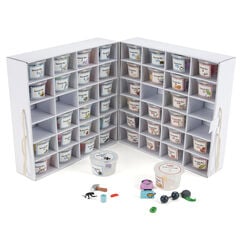There are so many elements that make children successful writers. Even when they have mastered their handwriting and phonics skills, they also need to understand how to construct a sentence, what elements a sentence needs to include and how to combine sentences to create longer pieces of writing. No wonder this is challenging for children and everything we can do to provide lots of opportunities for practice will surely help them to make progress with their writing.
In this blog, we have collated a selection of engaging writing activities that can help you to assess where children are with their writing and help them to make progress.
Activities
Story Circle
A small group activity to stimulate creative talk before writing using the Creative Writing Tubs.
- Sit in a circle with a selection of objects or your chosen writing tub.
- Start your story with one person choosing an object and saying aloud a sentence, e.g. ‘A shiny spaceship zoomed through the sky into space’.
- Pass the box to the next person to continue the story by choosing another object and creating a sentence, e.g. ‘A huge alien saw the spaceship whizzing past’.
- Continue round the group developing your story as you go.
You could ask children to write up the story afterwards and use this to identify the areas children are confident with and those to work on next.

What’s missing?
Help children to learn about different word classes using the Super Sentence Tubs.
- Create a range of sentences with one or two words missing, e.g. ‘The big swam’.
- Ask children to identify what word they think is missing and why, e.g. the missing word must be a noun because there is no noun in the sentence.
- Discuss suggestions about what word they could or could not include based on the other words within the sentence, for example, with the verb swam having been used, could we use the noun flower?
- You can adapt the sentences and word classes you explore for this activity based on the objective of your lesson.
Sort the Sentence
Help children to develop their understanding of sentence structure using the Super Sentence Tubs.
- Before the lesson, create a range of sentences (using the foam pieces) and then rearrange the words in each sentence, e.g. red – was – big – hammer – . – The
- Explain to the children that something has happened and your sentences have become jumbled, maybe a class puppet has been up to mischief! You need their help to sort it.
- Children have to read the words in the sentence and then rearrange the pieces so that the sentence make sense.
- Spend time discussing and exploring the sentence structure, looking for clues such as capital letters and identifying whether there is more than option for the rearranged sentence.
Funny Phrases
A great activity to explore different word classes using the Language for Living SPaG Pack.
- Use the Word Classes cards from the SPaG pack or collate a selection of words.
- Pupils can work in pairs and create funny phrases using one noun, verb, adverb, adjective, preposition and pronoun card, e.g. The crazy dog scampers cheekily over me.
- Children can then mime their phrase and ask another pair/whole class to try and figure it out.
One Off Writes
- Choose a writing activity from the One Off Writes Cards and set up an inspiring stimulus, such as a dinosaur visit.
- Follow the warm up activities on the cards and then let children have a go at their writing.
- You could use these activities as an opportunity for a guided writing session, shared writing or use it to inform your assessment to help you plan targeted support for children.
Silly Sentences
Help children to use their phonics skills for writing using the 44 Sound and Spelling Tubs.
- Choose one of the sound tubs and lay out all the objects.
- Get children to think of a sentence or short story featuring all of the objects and share it aloud.
- Ask them to write their sentence or story down trying to make the correct grapheme (spelling) choice each time. An example from the long /o/ tub could be: ‘On my way home from school I saw an erupting volcano, a big goat, a pink flamingo with a traffic cone on its head and a boy making a snowman!’










